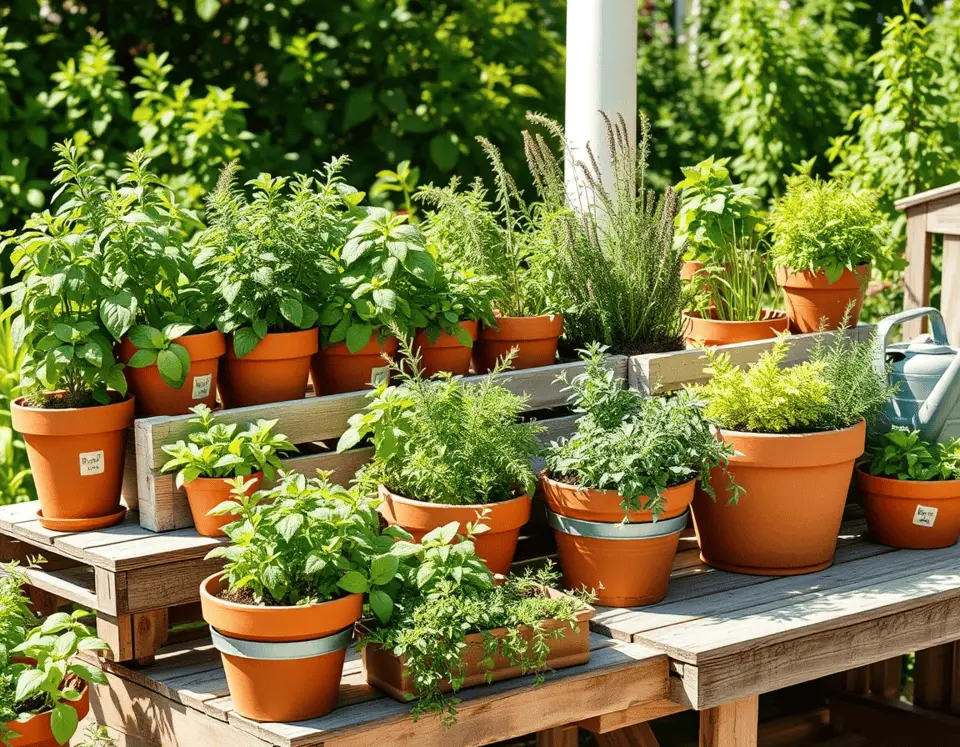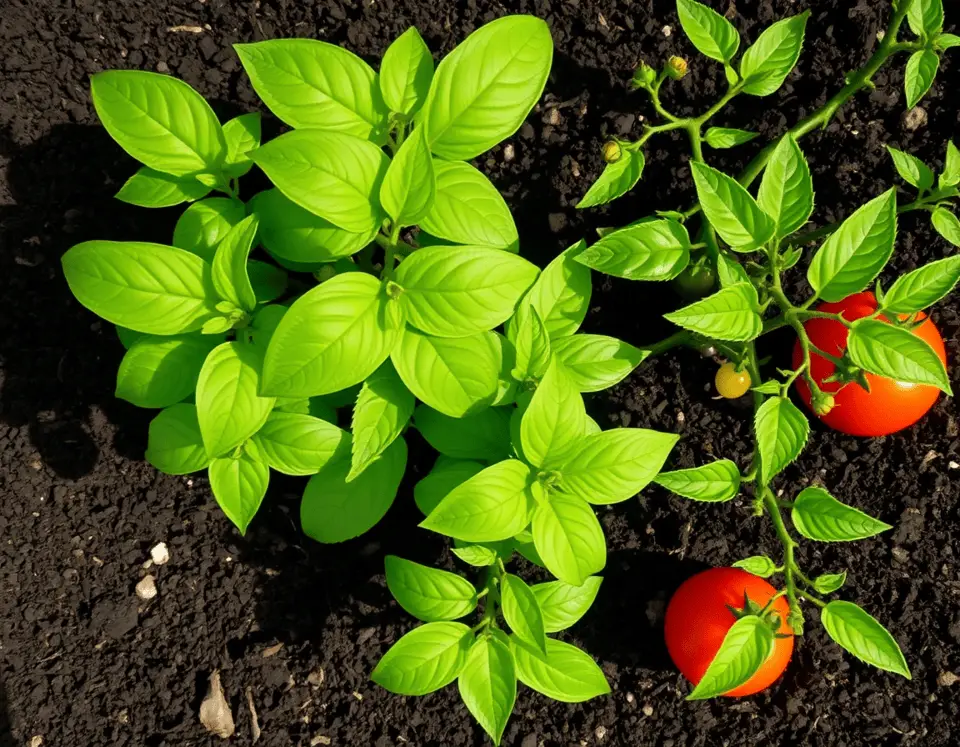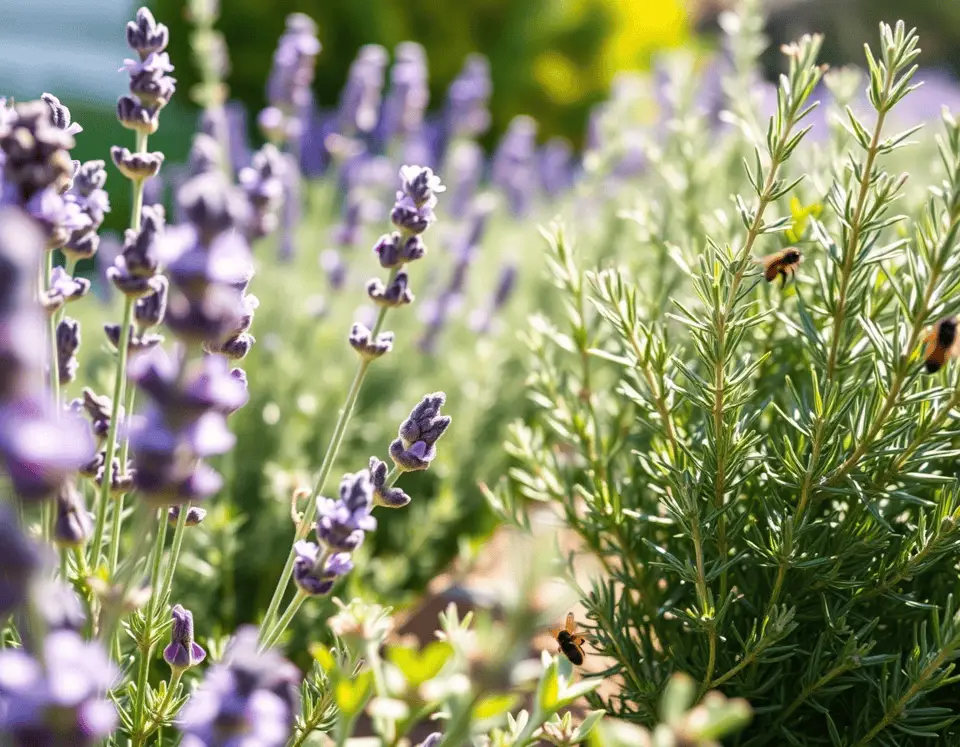Herb Companion Planting Chart You’ll Actually Use!
Companion planting with herbs is a holistic gardening approach that leverages the natural affinities and defenses of various plants. By understanding these relationships, gardeners can create vibrant, resilient, and productive spaces that require fewer chemicals and less maintenance.
This guide will walk you through the fundamentals of herb companion planting, provide a comprehensive and easy-to-use herb companion planting chart, and offer expert advice to help you design a flourishing garden ecosystem that supports both your plants and the environment.
Table of Contents
- 1 What Is Herb Companion Planting?
- 2 Why Practice Companion Planting with Herbs?
- 3 🌿 Herb Companion Planting Chart — 50 Herbs Edition
- 4 Best Herb Pairings and Their Benefits
- 5 Herbs to Avoid Planting Together
- 6 Tips for Successful Herb Companion Planting
- 7 Expert Insights: Maximizing Your Garden’s Potential
- 8 Conclusion
- 9 Author
What Is Herb Companion Planting?
Herb companion planting involves strategically positioning herbs together or near vegetables and flowers to take advantage of their unique properties and interactions. Each herb has its own set of characteristics-such as aroma, growth habit, and nutrient requirements-that can influence its neighbors in positive or negative ways.
By carefully selecting which herbs to plant side by side, gardeners can naturally deter pests, attract helpful insects, and even enhance the growth and taste of their crops. This practice not only supports healthier plants but also encourages a more balanced and diverse garden environment, where nature’s checks and balances are in full effect.
Why Practice Companion Planting with Herbs?
Key Benefits:
- Natural Pest Control: Many herbs release aromatic oils and compounds that can mask the scent of nearby crops or repel unwanted insects, making them less vulnerable to infestations.
- Biodiversity Boost: Interplanting a wide range of herbs and vegetables increases the diversity of your garden, which invites a broader spectrum of pollinators and beneficial predators, strengthening your garden’s natural defenses.
- Soil Health Improvement: Certain herbs, such as those that fix nitrogen or have deep taproots, can enhance soil structure and fertility, benefiting surrounding plants by making nutrients more available.
- Efficient Use of Space: Companion planting allows you to maximize every inch of your garden, as herbs can fill gaps between larger plants, act as living mulch, and help suppress weeds, all while providing culinary and medicinal value.
🌿 Herb Companion Planting Chart — 50 Herbs Edition
Below is an expanded, in-depth chart to guide you in pairing popular herbs with their most compatible companions and noting which combinations to avoid. This chart is designed to help you make informed decisions when planning your garden, ensuring that each plant supports its neighbors for optimal health and productivity.
| Herb | Good Companions | Avoid Planting With | Benefits & Notes |
|---|---|---|---|
| Basil | Tomatoes, Peppers, Lettuce, Oregano, Marigold | Rue, Sage, Cucumbers | Boosts tomato flavor, repels aphids, mosquitoes. Attracts bees. |
| Chives | Carrots, Tomatoes, Roses, Strawberries | Beans, Peas | Repels aphids, Japanese beetles, improves flavor, helps roses resist mildew. |
| Dill | Cabbage, Lettuce, Cucumbers, Onions | Carrots, Cilantro, Tomatoes (when mature) | Attracts ladybugs, deters cabbage worms. Bolts fast in heat. |
| Mint | Cabbage, Peas, Broccoli, Tomatoes | Parsley, Chamomile, Rosemary | Powerful pest repellent. Spreads aggressively — use containers. |
| Oregano | Cabbage, Broccoli, Grapes, Eggplant | None notable | General pest deterrent, attracts beneficial insects. |
| Parsley | Tomatoes, Asparagus, Corn, Chives | Lettuce, Mint, Alliums | Attracts hoverflies, parasitic wasps. Helps asparagus and tomato growth. |
| Rosemary | Carrots, Beans, Cabbage, Lavender | Basil, Mint, Cucumbers | Deters cabbage moths, carrot flies. Loves dry soil and full sun. |
| Sage | Cabbage, Carrots, Strawberries, Beans | Cucumbers, Rue, Onions | Deters cabbage moths, carrot flies. Drought tolerant. |
| Thyme | Tomatoes, Cabbage, Strawberries, Eggplant | None known | Deters whiteflies, cabbage worms. Great ground cover. |
| Cilantro | Spinach, Peppers, Tomatoes, Beans | Fennel, Mature Dill | Attracts lacewings, repels aphids. Bolts fast—succession planting helps. |
| Fennel | None (plant alone) | Nearly all herbs and vegetables | Inhibits other plants’ growth. Attracts swallowtail butterflies. |
| Marjoram | Most vegetables (peas, onions, beans) | None significant | Enhances flavor, attracts pollinators. Good all-purpose herb. |
| Tarragon | Tomatoes, Eggplant, Peppers, Broccoli | None known | Pest deterrent, growth booster. Drought tolerant. |
| Lemon Balm | Tomatoes, Squash, Fruit trees | Fennel | Attracts pollinators, repels gnats and mosquitoes. Can spread fast. |
| Bay Laurel | Beans, Carrots, Onions | Basil | Deters flies and moths. Slow grower, likes warmth. |
| Lovage | Most garden vegetables | None notable | Boosts neighbor growth, attracts pollinators. Tall, may shade plants. |
| Chamomile | Onions, Cabbage, Broccoli, Kale | Mint | Attracts bees and hoverflies, improves herb flavor. |
| Summer Savory | Beans, Onions, Garlic, Peas | None notable | Improves bean flavor, deters bean beetles. |
| Borage | Tomatoes, Squash, Strawberries | None known | Attracts bees, deters tomato hornworms. Self-seeds easily. |
| Catnip | Collards, Beets, Squash | Peas | Repels flea beetles, aphids, squash bugs. Attracts cats. |
| Bee Balm (Monarda) | Tomatoes, Peppers, Squash, Corn | None known | Attracts pollinators, improves tomato flavor. |
| Hyssop | Grapes, Cabbage, Cauliflower | Radish | Attracts bees, deters cabbage moths. Strong scent. |
| Garlic Chives | Tomatoes, Beets, Apples, Lettuce | Beans | Pest deterrent, prevents fungal disease. Easy to grow. |
| Anise | Coriander (Cilantro), Lettuce | Basil, Carrots | Attracts beneficial insects, improves cilantro growth. |
| Burnet | Lettuce, Onions, Cucumbers | None known | Helps lettuce resist bolting. Edible cucumber flavor leaves. |
| Wormwood | Plant near crops but not too close | Most edible crops | Natural insecticide, toxic near plants. Use at garden edges. |
| Angelica | Parsley, Carrots | None notable | Attracts pollinators and beneficial wasps. Large, tall plant. |
| Basil, Holy (Tulsi) | Tomatoes, Peppers, Roses | None known | Repels mosquitoes, attracts pollinators, sacred herb in some cultures. |
| Caraway | Cabbage, Beans, Peas | None notable | Attracts beneficial insects, supports legume growth. |
| Catmint (Nepeta) | Roses, Cabbage, Beans | None known | Repels aphids and flea beetles, attracts pollinators. |
| Coriander (Cilantro) | Tomatoes, Spinach, Peas | Fennel, Mature Dill | Attracts beneficial insects, quick bolting. |
| Echinacea | Tomatoes, Beans, Squash | None | Attracts pollinators, medicinal properties. |
| Feverfew | Tomatoes, Beans | None | Repels pests, medicinal herb. |
| Garlic | Roses, Tomatoes, Carrots, Peppers | Beans, Peas | Repels aphids, beetles, and spider mites. |
| Goldenrod | Tomatoes, Peppers | None | Attracts pollinators and beneficial insects. |
| Horehound | None notable | None | Medicinal herb, attracts pollinators. |
| Lemon Verbena | Roses, Tomatoes | None | Attracts pollinators, fragrant. |
| Lemongrass | Tomatoes, Peppers | None known | Repels mosquitoes and aphids. |
| Lovage | Most veggies | None | Tall herb, improves flavor of neighbors. |
| Meadowsweet | Roses, Fruit trees | None | Attracts pollinators, medicinal uses. |
| Mint (Chocolate, Apple, Spearmint) | Cabbage, Peas | Parsley, Chamomile | All mint varieties spread aggressively; use containers. |
| Nasturtium | Tomatoes, Cucumbers, Beans | None | Repels aphids, attracts predatory insects. |
| Pennyroyal | Beans, Cabbage | Cats, Dogs (toxic) | Repels fleas, ticks, and mosquitoes. |
| Rue | Grapes, Fruit trees | Basil, Fennel | Repels Japanese beetles and aphids but toxic to humans. |
| Sorrel | Strawberries, Potatoes | None known | Adds tart flavor, attracts beneficial insects. |
| Sweet Woodruff | Strawberries, Shade plants | None known | Ground cover, attracts pollinators. |
| Valerian | Tomatoes, Fruit trees | None known | Improves root growth, attracts pollinators. |
| Winter Savory | Beans, Peas, Cabbage | None | Deters bean beetles and cabbage moths. |
Quick Growing Notes:
- Mint, oregano, lemon balm, and catnip spread aggressively—contain or grow in pots.
- Fennel and rue should be isolated because they can inhibit other plants.
- Herbs like rosemary, thyme, sage, and lavender thrive in dry, sunny spots.
- Basil, parsley, cilantro prefer more moisture and partial shade.
Best Herb Pairings and Their Benefits
Basil and Tomatoes: The Classic Duo
- Why it works: Basil is famous for its ability to repel tomato hornworms, thrips, and whiteflies, which are common threats to tomato plants. Its aromatic oils can also boost the flavor and yield of tomatoes, making this pairing a favorite among gardeners and chefs alike.
- How to plant: Plant basil seedlings around the base of tomato plants, spacing them 12-18 inches apart to allow for airflow and sunlight. Regularly pinch back basil to encourage bushy growth, and harvest leaves frequently to keep both plants healthy and productive throughout the season.
Chives and Carrots: Pest-Repelling Partners
- Why it works: Chives release sulfur compounds that naturally deter carrot flies and aphids, two pests that can devastate carrot crops. In addition, chives can enhance the flavor of carrots and improve their overall health, making them a valuable addition to any vegetable bed.
- How to plant: Sow chives as a border along carrot rows or intersperse clusters throughout the bed. Chives are perennial, so they’ll return year after year, providing ongoing protection and flavor enhancement for your carrots and other nearby crops.
Rosemary and Cabbage: Defense Against Moths
- Why it works: Rosemary’s strong, pine-like scent confuses and repels cabbage moths, carrot flies, and other pests that target brassicas. This natural deterrent helps reduce the need for chemical sprays and supports healthier, more robust cabbage plants.
- How to plant: Position rosemary near cabbage, broccoli, or carrots, ensuring it receives plenty of sunlight and well-drained soil. Avoid planting rosemary near basil or mint, as their differing water and soil needs can lead to poor growth for both herbs.
Mint: A Powerful Pest Deterrent (But Contain Its Roots!)
- Why it works: Mint is renowned for its ability to repel a wide range of pests, including aphids, flea beetles, ants, and even mice. Its strong scent also attracts beneficial insects like bees and hoverflies, which help with pollination and pest control.
- How to plant: To prevent mint from spreading uncontrollably, plant it in containers or sink pots into the ground. Place these containers near crops that need protection, such as cabbage or tomatoes, to maximize mint’s pest-repelling benefits without risking garden takeover.
Dill and Brassicas: Attracting Beneficial Insects
- Why it works: Dill’s delicate flowers are a magnet for beneficial insects like ladybugs, lacewings, and parasitic wasps, all of which prey on common brassica pests. Dill can also improve the flavor of lettuce and help deter aphids and spider mites.
- How to plant: Interplant dill with cabbage, broccoli, or kale, but keep mature dill away from carrots and tomatoes, as it can inhibit their growth. Allow some dill to flower to attract the maximum number of beneficial insects to your garden.
Herbs to Avoid Planting Together
Some herbs can have negative effects on each other or their neighbors due to competition for resources, allelopathic chemicals, or incompatible growth habits. Understanding these relationships is crucial for maintaining a healthy and harmonious garden.
- Fennel: This herb produces chemicals that inhibit the growth of most other plants, including many herbs and vegetables. It’s best grown in a dedicated spot, well away from other crops, to prevent stunted growth or reduced yields in your garden beds.
- Mint and Parsley: Both herbs can be aggressive growers, spreading quickly and competing for space, water, and nutrients. To avoid overcrowding and resource depletion, keep mint and parsley in separate containers or plant them far apart in the garden.
- Basil and Sage: These two herbs have different environmental preferences; basil thrives in moist, rich soil, while sage prefers drier, well-drained conditions. Planting them together can lead to poor growth for both, so it’s best to keep them in separate areas.
Tips for Successful Herb Companion Planting
- Rotate Crops: Changing the location of your herbs and vegetables each year helps prevent the buildup of soil-borne diseases and pests, while also maintaining soil fertility and structure.
- Allow Some Herbs to Flower: Letting a portion of your herbs go to flower provides food for pollinators and beneficial insects, which in turn help control pest populations and improve pollination rates for your crops.
- Mix Annuals and Perennials: Combining fast-growing annual herbs with long-lived perennials creates a dynamic and productive garden that offers benefits throughout the growing season and beyond.
- Monitor Growth and Adjust: Every garden is unique, and factors like soil type, climate, and plant varieties can affect the success of your companion plantings. Observe your plants closely, take notes on what works, and be willing to adjust your pairings as needed to achieve the best results.
Expert Insights: Maximizing Your Garden’s Potential
“Viewing your garden as a living system, where every plant plays a role in supporting the whole, allows you to make more informed and effective planting decisions.”
- Experiment and Learn: While many companion planting combinations are supported by tradition and observation, your local conditions may yield different results. Keep a gardening journal to track which pairings work best in your space and refine your approach each season.
- Encourage Diversity: The more variety you introduce into your garden, the more resilient it becomes. Diverse plantings create a robust ecosystem that is better equipped to withstand pests, diseases, and environmental stresses, leading to healthier plants and higher yields.
Conclusion
Herb companion planting is an invaluable practice that combines traditional wisdom with modern ecological understanding. By thoughtfully pairing herbs and other plants, you can create a garden that is not only beautiful and productive but also self-sustaining and environmentally friendly. Use the expanded chart and expert tips provided above to design a thriving garden where every plant contributes to the success of its neighbors. With careful planning, observation, and a willingness to experiment, you’ll enjoy healthier plants, fewer pests, and bountiful harvests season after season.









